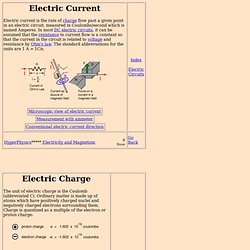

DC. Electric current. The unit of electric charge is the Coulomb (abbreviated C).

Ordinary matter is made up of atoms which have positively charged nuclei and negatively charged electrons surrounding them. Charge is quantized as a multiple of the electron or proton charge: The influence of charges is characterized in terms of the forces between them (Coulomb's law) and the electric field and voltage produced by them. One Coulomb of charge is the charge which would flow through a 120 watt lightbulb (120 volts AC) in one second. Electric voltage. Ohm's Law. The voltage changes around any closed loop must sum to zero. No matter what path you take through an electric circuit, if you return to your starting point you must measure the same voltage, constraining the net change around the loop to be zero. Since voltage is electric potential energy per unit charge, the voltage law can be seen to be a consequence of conservation of energy. The voltage law has great practical utility in the analysis of electric circuits. It is used in conjunction with the current law in many circuit analysis tasks.